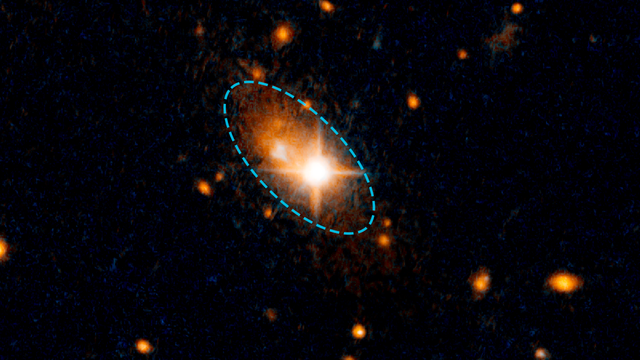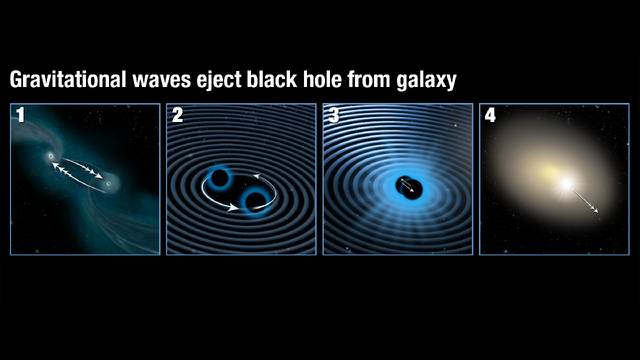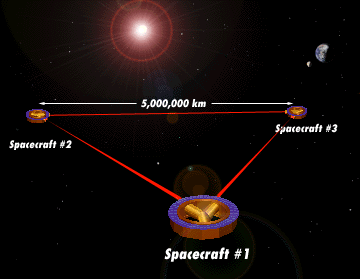innerGlitch | The Sound of the Void
This is “Quasar 3C 186”, not a fascinating name for a Quasar, but it surely is one of the most fascinating ones.
You can picture a quasar as a huge spinning disc of super hot material powered by a supermassive black hole (usually) billions of time bigger than our sun.
They are frightening powerful and huge.
3C 186 weights ~1 billion suns and as you can see it is off-centre relative to its galaxy central hub and moving away from it.
Now something should have caused this quasar to move, but what could have been?
It is estimated that the energy needed to move that enormous object is equivalent to the energy released by 100 million Supernovas exploding at the same time, an event so violent that can be explained only by one event.
Gravitational waves
Quasar 3C 186 is probably the result of two galaxies merging together, but in this case something was offset.
This reconstruction provided by Hubblesite.org shows how the black holes of the two galaxies started whirling around each other producing stronger gravitational waves while getting closer to one another. Maybe more gravitational waves were produced by one side and that propelled the newly formed quasar away from its original position.
Moving an object so massive is not an easy task and that gives us an idea of how much energy is released in the process described above. So much energy, in fact, that the fabric of the cosmos starts “shaking”, creating what we call Gravitational Waves.
So, if these gravitational waves are created during this extremely violent and spectacular events we should be able to detect them easily, right?
Short answer: No.
Imagine to throw a huge rock at the center of lake, you will see the surface of the water starting to ripple and then creating concentring waves moving away from the spot you throw the rock and fading to the shore. Now imagine that the surface of the lake is actually the space-time of the universe and the rock is the energy released by two black holes merging together, the crests and troughs are bigger near their origin but become smaller as they move away.
The creation of 3C 186 (for instance) happened far away in space and time and we need incredibly accurate instruments to measure gravitational waves coming from so distant sources.
Looking at the invisible
This is the pattern detected by LIGO (Large Interferometer Gravitational-wave Observatory) on 14th September 2015 and converted in sound waves.
The sound you hear from the clip is the frequency of the wave in space-time and it is the result of two black holes whirling and merging around 1.3 billion years ago.
A fun fact: Imagine for a moment to be in an absolutely empty universe near two orbiting black holes, it is conceivable you will hear gravitational waves as actual sound thanks to your eardrum responding to the change of space and time because they “ring” the space-time in the human auditory range and need no medium to travel through except space-time itself.
Meet now LISA, a joint project between ESA and NASA, which stands for Laser Interferometer Space Antenna (Everybody loves acronyms) and it will be the next generation gravitational waves detector.
The problem with LIGO is given by the sensibility of its sensors which shake or give false positives when, for example, a truck passes near the observatory. LISA will be launched in space around 2030 and it will consist of (probably) 3 modules placed in a triangular shape about 5 Million km apart from each other.
In space there are no trucks, so there will be less interference and the large distance between each space module will help us detect smaller gravitational waves which come from more distant places in space and time.
Basically the goal of the mission is to look back in time when the universe was less than a second old, in the moment when the universe was starting to expand and everything was so insanely hot and dense that even light was trapped inside that messy hotness.
In fact, if we try to look somewhere in any direction to a time around ~13.5 billion years ago there is something like a wall, we cannot see further back in time. And the “wall” starts when the universe was already ~400.000 years old.
There were lots of interesting stuff going on before that time and we cannot see them because that light can’t reach us, but gravitational waves can!
If, and it is a huge “if”, the gravitational waves of that era are still intact and detectable we, for the first time in human history, will see what the universe, the stuff that makes us all and everything that will ever be... came into existence.



Very interesting! Did not know about quasars until know. Good content! Whale done:)
Thanks, it's nice to have your review here :-)
@bendelgreco got you a $2.83 @minnowbooster upgoat, nice! (Image: pixabay.com)
Want a boost? Click here to read more!
This post has received a 0.60 % upvote from @booster thanks to: @bendelgreco.
Congratulations @bendelgreco! You have completed some achievement on Steemit and have been rewarded with new badge(s) :
Click on any badge to view your own Board of Honor on SteemitBoard.
For more information about SteemitBoard, click here
If you no longer want to receive notifications, reply to this comment with the word
STOP